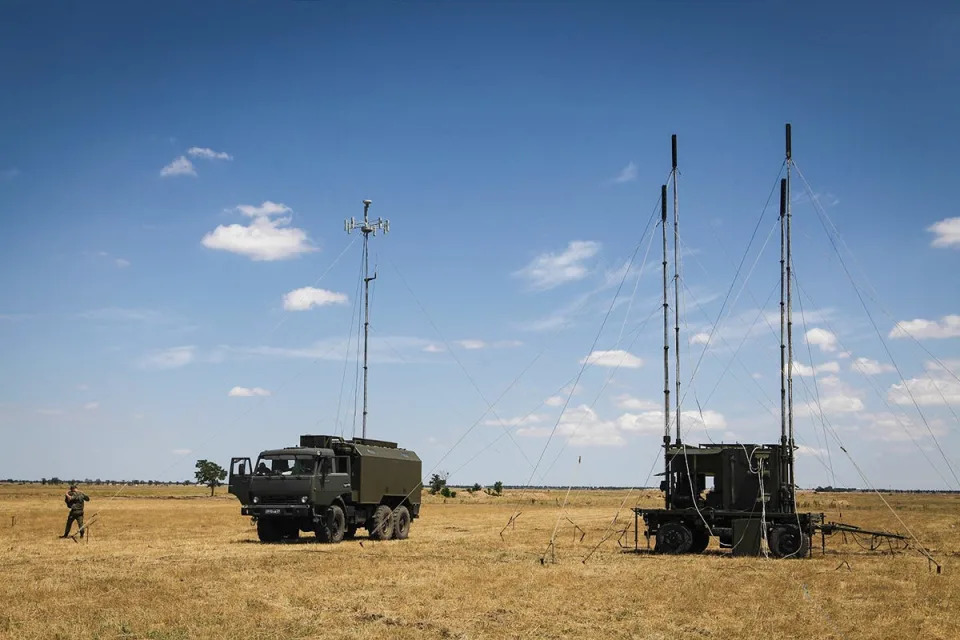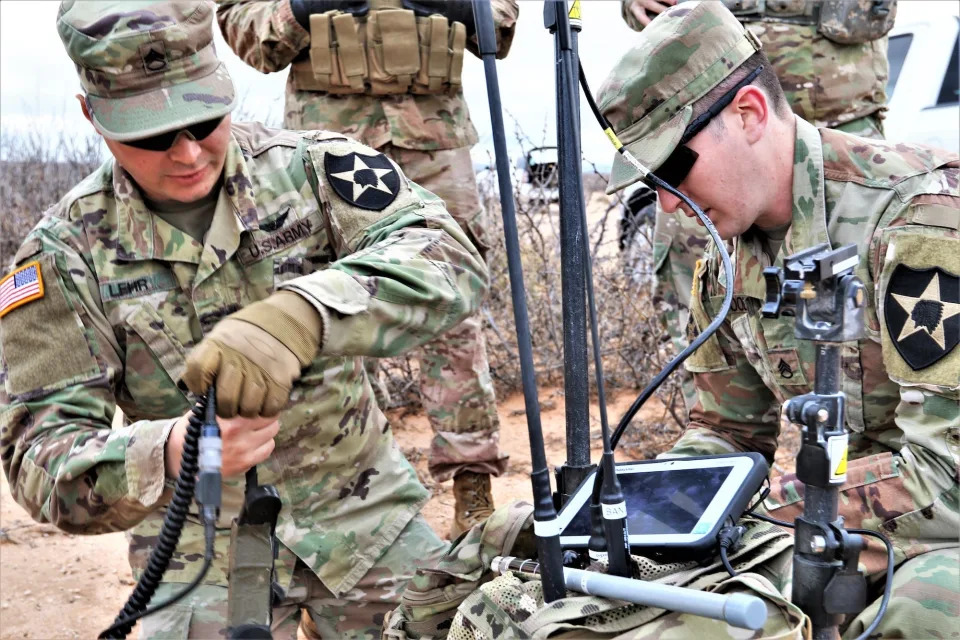
Russian electronic warfare has created problems for some American-made precision weaponry in Ukraine, but Moscow is also showing its hand and telling the US what it needs solutions for to be ready for future fights.
Ukraine has employed US precision weapons, such as the HIMARS-fired Guided Multiple Launch Rocket Systems and air-launched Joint Direct Attack Munitions, throughout the war, but widespread Russian electronic warfare is regularly diminishing the effectiveness of these weapons.

Lt. Gen. Antonio Aguto, who’s serving as the commander of Security Assistance Group-Ukraine, addressed the problem in December, saying electronic warfare directed at some of the US’s “most precise capabilities” was “a challenge.” Other US officials have identified these issues as well, adding that the US and Ukraine were working on solutions.
Any fixes developed to effectively counter the challenge posed by electronic warfare won’t just benefit Ukraine. They’re also set to help the US solve problems it has long been concerned about as it prepares for the possibility of great-power conflict.

Mark Cancian, a retired Marine Corps colonel who’s a senior advisor at the Center for Strategic and International Studies, explained to Business Insider that “the widespread GPS spoofing we see in Ukraine adds urgency to solving a problem DoD has long recognized: that wartime spoofing will reduce the effectiveness of its weapons.”

Electronic warfare can be executed using cheap but effective technology, and both sides of the war are using it extensively. And these tactics are not used solely to foil precision-guided munitions. They can also be used to scramble the connection between an operator and a reconnaissance or strike drone.
Electronic warfare is a broad term that includes a variety of inexpensive options. Thomas Withington, an expert in electronic warfare and air defense who’s an associate fellow at the Royal United Services Institute, said jamming was relatively straightforward, explaining to BI that it involved “blasting a GNSS receiver with noise to cause it to lose the position, navigation, and timing signal that it received from the satellite.”
Spoofing, on the other hand, involves sending false GNSS information to the weapon’s navigation system, sending it off course or trajectory. Jamming is easier and can be done with cheaper equipment and engineers, while spoofing is likely to be used in more specific instances, such as hiding locations from the enemy.
Both serve different purposes, but in either case, the effects can be deeply problematic for precision weaponry.
Ukraine has managed to adapt to the challenge, in some cases, by engaging in jamming of its own or locating Russian electronic-warfare sites and destroying them. Relying on alternative systems that don’t depend on GPS or use other guidance systems, such as an inertial guidance system, helps bypass the problem. That’s not always an option, though.
Within the Russian military, there’s probably been increased interest in employing electronic warfare in battle, especially over the past year or so, because it’s so effective at countering US-provided precision weapons.
Precision systems — such as Excalibur and GMLRS, which can be fired from US-provided M777 howitzers and HIMARS, respectively — are seeing shockingly decreased accuracy because of jamming.
“The philosophy behind weapons like Excalibur and JDAMs was that their reliance on GNSS, to an extent, was supposed to provide a level of precision,” Withington said.
He said the capability and accuracy of those much-vaunted weapons were now in question, adding that it “not only has tactical and operational ramifications for the Ukrainians,” but it could also raise questions about “the wider confidence others have in those systems.”
Daniel Patt, a senior fellow at the Hudson Institute, wrote in a statement to Congress in March that the 155mm GPS-guided Excalibur artillery shell “had a 70% efficiency rate hitting targets when first used in Ukraine” but that “after six weeks, efficiency declined to only 6% as the Russians adapted their electronic warfare systems to counter it.”
Patt added that “the peak efficiency of a new weapon system is only about 2 weeks before countermeasures emerge.” That’s valuable information for the US as it prepares for future fights.

The war in Ukraine has, as a defense expert previously told BI, been an “intelligence bonanza” and is giving the US an opportunity to learn how its precision weapons perform under modern threats such as electronic warfare. It’s not theoretical. Instead, the US is watching a rival power engage its weapons in a real war.
Intelligence from the war builds on and probably advances years of research and discussion among US defense officials and experts about how electronic warfare would impact America’s arsenal in a great-power conflict and how the US would need to adapt.
Cancian said the Department of Defense had been working on overcoming these threats by focusing on options such as using narrower signal bands or the generation of stronger signals that are able to burn through jamming attempts.
The threats, nevertheless, “remind us to be careful about expecting ‘game changers,'” he said. “The other side always develops countermeasures that reduce effectiveness.”
Despite the challenges, the US shouldn’t completely write off its precision weapons should it one day find itself in a war with another great power, be it Russia or China, which would almost certainly employ electronic warfare as well.
Withington said that “even if that jamming has been quite successful, the tactical imperative behind this is to work out a way to outflank the effectiveness of that electronic attack,” adding that while a strong Russian jamming signal might be effective, it’d also be easier to detect and destroy.
At a media event earlier this month, Doug Bush, the Army’s acquisition chief, said it wasn’t surprising Russia was able to jam US weapons. He said it was part of a “constant cycle” of innovation on both sides, adding that the US was learning that “with any precision weapon, you want multiple ways to guide it to its target.”
For some weapons, that’s already in the works. Earlier this week, the US Air Force announced a contract for add-on seekers for its extended-range JDAMs, the goal being to improve the JDAM to resist electronic jamming and instead lock onto the source of the jamming, targeting it.
Bush said the Army had created a team focused on adapting its weapons to electronic-warfare issues long before the war in Ukraine, signaling the Pentagon’s clear understanding of the problem these capabilities pose.
Bush previously said in August that the Army was “fundamentally reinvesting in rebuilding our tactical electronic-warfare capability after that largely left the force over the last 20 years” and that the war in Ukraine had added “urgency” to those efforts.

Withington said efforts to adapt precision weapons to the threat were just one facet of a multilayered solution. Other solutions to the problem involve using other weapons and prioritizing targeting the point of origin for electronic-warfare signals early in a conflict.
“It is imperative that forces like the US and its allies see future battle in a case that they have to first establish electromagnetic superiority,” he said, explaining that denying enemies from using the electromagnetic spectrum in any way would “massively degrade at the very least, if not prevent altogether” an enemy from interfering with its weapons.
Ultimately, though, as the US and Ukraine adjust to Russia’s jamming and learn from the war, the “constant cycle” of innovation, as Bush said, is set to continue.
“The measure, countermeasure, counter-countermeasure that we’re seeing in Ukraine is typical in war,” Cancian said, adding that “no technology provides the ultimate advantage.”
Credit: Yahoo News
